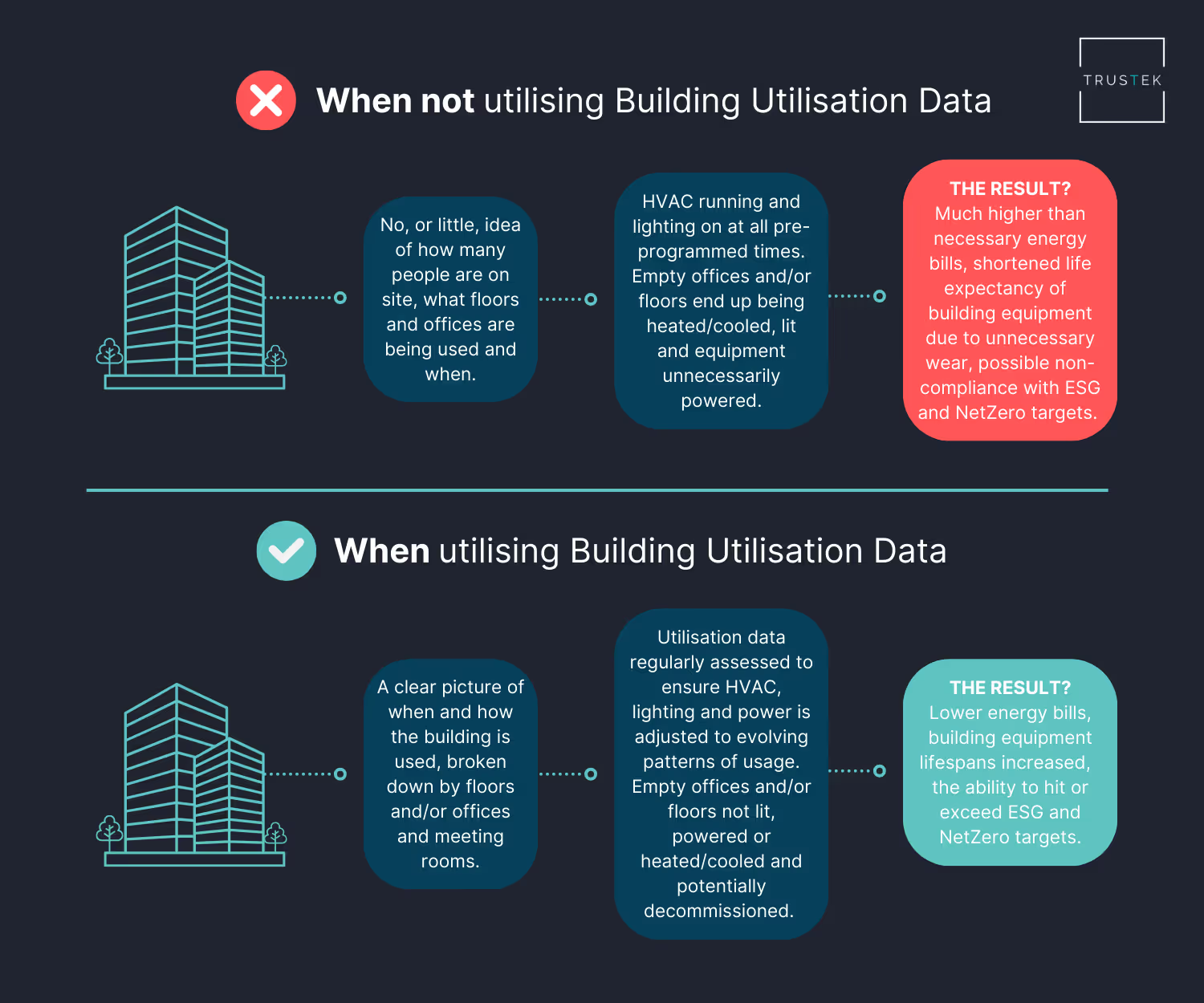How many times have you heard a building manager say “we have roughly 300 people in the building a day" or “we get about 4000 people on site a week”?
In the golden age of offices, when clocking in by nine and clocking out after five was the norm, this was no problem. But post-pandemic, with the changing patterns of office use and many of us flexibly working, these statements are assumptions not facts.
If you’re still running a building without knowing when it is being used, you’re likely wasting a lot of money, not getting the best out of the technology in place, and burning tonnes of saveable carbon..
In short? Overlooking utilisation data is a missed opportunity to proactively manage an asset that reduces costs and improves relationships with tenants and landlords.

Capturing the data: Technologies that support Data Utilisation
%2520(2).png)
This overlooked data set can be collected in numerous ways, some requiring new technology, others not. In 2022 the Data Utilisation module of our Building Audits found that 67% of buildings audited still collected data via paper-based systems, had no training in place and didn’t analyse data. In contrast, the highest scoring buildings effectively used tech, such as those listed below, to track utilisation & made data informed changes.
Public Wi-Fi - Wireless access points
This technology, which is often already on-site, can provide indicative numbers of people in the building and where they go, by anonymously tracking IP addresses from mobile phones and wearables. This data will not provide you with perfect information as one person could have multiple devices, but it will provide you with indicative trend information.
This information can be captured by companies such as LightFi and can indicate which floors and rooms are used when, allowing you to adjust heating, cooling and lighting appropriately.
Smart CCTV
Many CCTV providers now offer a smart analytics platform which can be installed to collect footfall data from the cameras. This may require an upgrade to the existing cameras technology.
However, providers such as Fyma can use legacy CCTV systems to provide this information on how a building is used. By turning existing hardware into an AI driven smart sensor, this technology can detect people and objects to increase revenue, optimise costs, and enhance user experiences.
Access Control
A technology already installed in many commercial offices, access control software will capture and store key card (or phone) data, allowing you to analyse numbers using the building, and daily and hourly building trends.
It can also provide information regarding lift and staircase usage if access control is deployed on these locations which can support Wellness strategies to promote staircase usage.
IoT People Counters
IoT (Internet of Things) people counters are specific devices installed over the main entrances and exits points in the building and can provide highly accurate utilisation data (~80-90%). When installed into the offices demise areas they can also supply workplace utilisation data to further optimise the buildings energy management.
These counters are typically small and discreet and can be installed at doorways or entrances. Part of Utopi’s offering, IoT People counters collect live data that can be analysed to make data-informed decisions.
Going old school
Over the last two years of our Building Audits, we’ve seen a multitude of data capture methods ranging from the above, to manual collection - occupier emails to handheld manual clickers.
Whilst this manual data collection acknowledges the need for data, they take up valuable resources, cannot provide the entry/exit times, and rely on occupier participation.
Analysing the data
The Data Utilisation module of our Building Audits have also highlighted that some buildings have one (or many) of the technologies above in place; it’s the processes around extracting and analysing this data that are lacking.
This challenge can be met by creating clear processes and reports. Time needs to be spent speaking to technology providers to set up or understand existing reporting, and teams at all levels need to ensure the right data is extracted – Building managers will need different data to landlords, ESG teams will need different information to Front of House Teams.
Some data is better than no data
It is important to remember that no platform can give you 100% accuracy. And you don’t need 100% to gain valuable insights. Often a data utilisation journey needs to start with what you already have. Analyse this, the processes in place and the impact it can drive, then build on it.
When we perform the Data Utilisation module of our Building Audits we do just that – asses the current technology, processes and people in place and suggest no-cost, low cost and significant investment improvements. There’s no point investing in a brand-new access control system if you’re not analysing and actioning the data you already have.
Next Steps?
1. Find out how utilisation data currently impacts your asset management and how to maximise it by booking an Audit >
2. Search the Verified Marketplace by Data Utilisation challenge to discover solutions that can support your data utilisation challenge >










-2.jpg)
.jpg)



